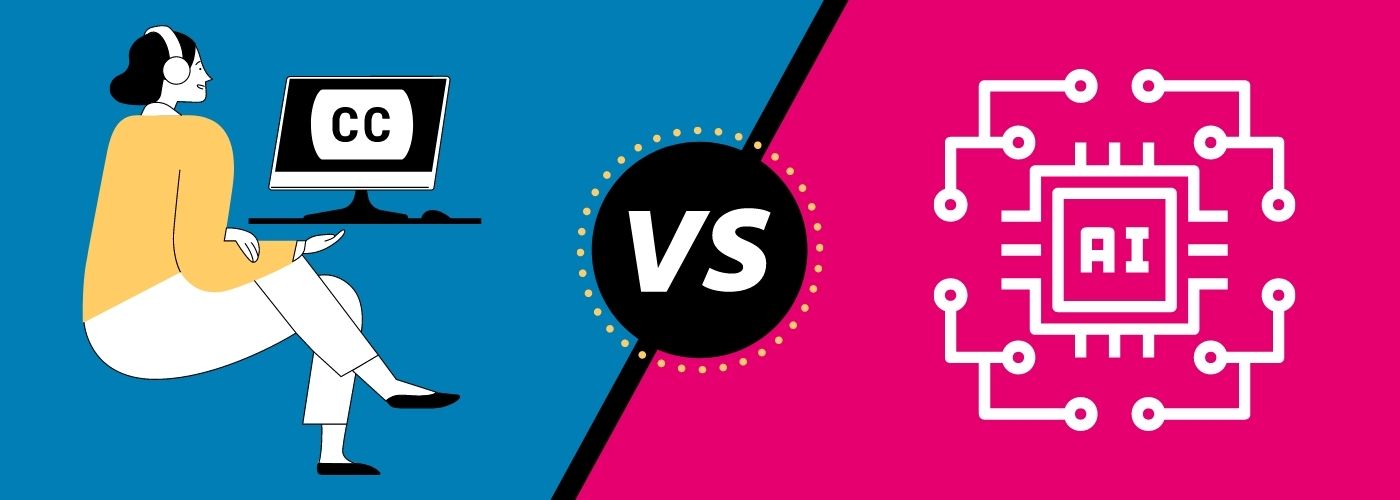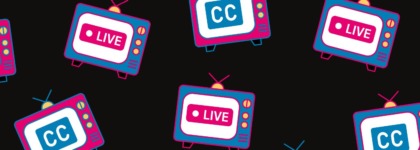Live Professional Captions vs. Live Auto Captions: Which is Right for You?
Updated: October 21, 2021
If you’re reading this blog, you’re probably interested in adding captions to your next live event. This is a great step in making live streams accessible to all audiences, including viewers who are d/Deaf or hard-of-hearing.
After deciding to add live captions, you’ll have some decisions to make. Namely, you’ll need to choose between using live professional captions or live auto captions. Both live captioning solutions deliver real-time captions for live events, but their production methods and results are quite different.
In this blog, we’ll go over the benefits and differences of both types of live captions so that you can make an informed decision for your next live event.
Download the 2020 State of Automatic Speech Recognition Report
Live professional captions (LpC) are created in various ways, but they always include a human captioner. Some standard methods include stenography or voice writing.
Live auto captions (LaC) are generated by machine learning algorithms and automatic speech recognition (ASR) technology.
Why use live auto captions?
The main benefits of live auto captions concern cost and ease of scheduling. Live auto captioning is a more affordable alternative for captioning live meetings and events than CART (Communication Access Realtime Translation) or human-powered live captioning, which tend to be more expensive. Live auto captioning also allows for easy scheduling, whereas human captioning often requires more time to hire a professional captioner and communicate with them on scheduling for your event.
Automatic captions also have the unique ability to minimize deletion errors (missing words from the live stream), which are common to live professional captioning solutions. Instead, ASR technology can pick up every word from a live stream with little latency.
Drawbacks to live auto captions
Although live auto captions have their benefits, they also have drawbacks. For example, even though auto captions capture all words, they will also make more substitution errors, which means that auto captions can be highly inaccurate.
Another drawback to live auto captioning is that many vendors rely on their own proprietary ASR technology, many of which haven’t been considered a contender in the ASR market or widely tested externally. Therefore, many live auto captioning services may not be a reliable or highly accurate option; for example, automatic captions can often have an accuracy rate as low as 50%.
If you use live auto captions, you’ll want to be sure to ask the right questions and select a highly accurate solution.
Learn about the current state of ASR technology ➡️
Why use live professional captions?
Live professional captions deliver highly accurate real-time captions. Their most significant benefits include their accuracy and quality. Unlike ASR technology, human captioners are trained professionals able to capture the speaker’s intent, ensuring that essential words are captioned correctly.
If you’re looking for the most accurate, legally compliant live captioning service, then live professional captions are the way to go!
Drawbacks to live professional captions
The biggest downside to live professional captioning is cost. Since this option uses professional captioners, humans need to be paid fairly for their time and effort. Live professional captions can be 3-4 times more expensive than live auto captions depending on the vendor you use.
Live professional captioning can also require more time to hire a professional captioner and communicate with them on scheduling for your event. Without proper planning, scheduling and hiring needs can get in the way of a successfully captioned live stream.
Discover how ASR technology impacts captioning accuracy ➡️
So, which option is right for your event?
Well, it depends.
If cost is your biggest concern, then live auto captions might be your best option. However, inaccuracy often prevents auto captions from being legally compliant. Although there are no official legal guidelines for live captioning quality, the best practice is to assume that live captions should be as close as possible to accurate.
If you have audience members who are d/Deaf or hard-of-hearing, then this accuracy is even more critical. The Americans with Disabilities Act (ADA) mandates reasonable accommodations for employees and “auxiliary aids and services” to ensure effective communication with people who are d/Deaf or hard-of-hearing. The U.S. Department of Justice regulations for ADA Title II (state and local governments) and ADA Title III (public accommodations) define the term “auxiliary aids and services” as including computer-aided transcription services and open and closed captioning.
Additionally, if you’re sharing a recording of the event online, you will need fully compliant captions and want to make sure your vendor has an upgrade path to full transcription.
You’ll also want to consider the type of event you’re hosting. Regardless of accommodation requests, conferences or large events should have highly accurate live professional captioning to ensure a comprehensive and equitable experience for all attendees. However, for small, internal meetings without any accommodation requests, live auto captions might work fine. In these instances, the accuracy of live professional captions might not justify their cost, and live auto captions may be all that’s needed.
If you do choose to use live auto captions for any event, we recommend the following measures for increased accuracy:
- Ensure high-quality audio, clear speakers, strong internet connection, and no overlapping speech.
- Upload a wordlist of any technical terms, phrases, or acronyms that will come up in your live event.
- Upgrade the recording to full transcription to ensure a legally compliant, 99%+ accurate caption file on the recording.
3Play’s Live Captioning
At 3Play Media, our live captioning solution allows you to schedule captions for any live event. We streamline the traditional live captioning workflow by integrating with many video platforms, including YouTube, Zoom, Brightcove, and more.
Our goal is to make video accessibility easy. With best-in-class ASR technology and custom features, we deliver a highly efficient and cost-effective captioning solution to make your live events accessible to all audiences.
Want to learn more?
Further Reading

Subscribe to the Blog Digest
Sign up to receive our blog digest and other information on this topic. You can unsubscribe anytime.
By subscribing you agree to our privacy policy.






